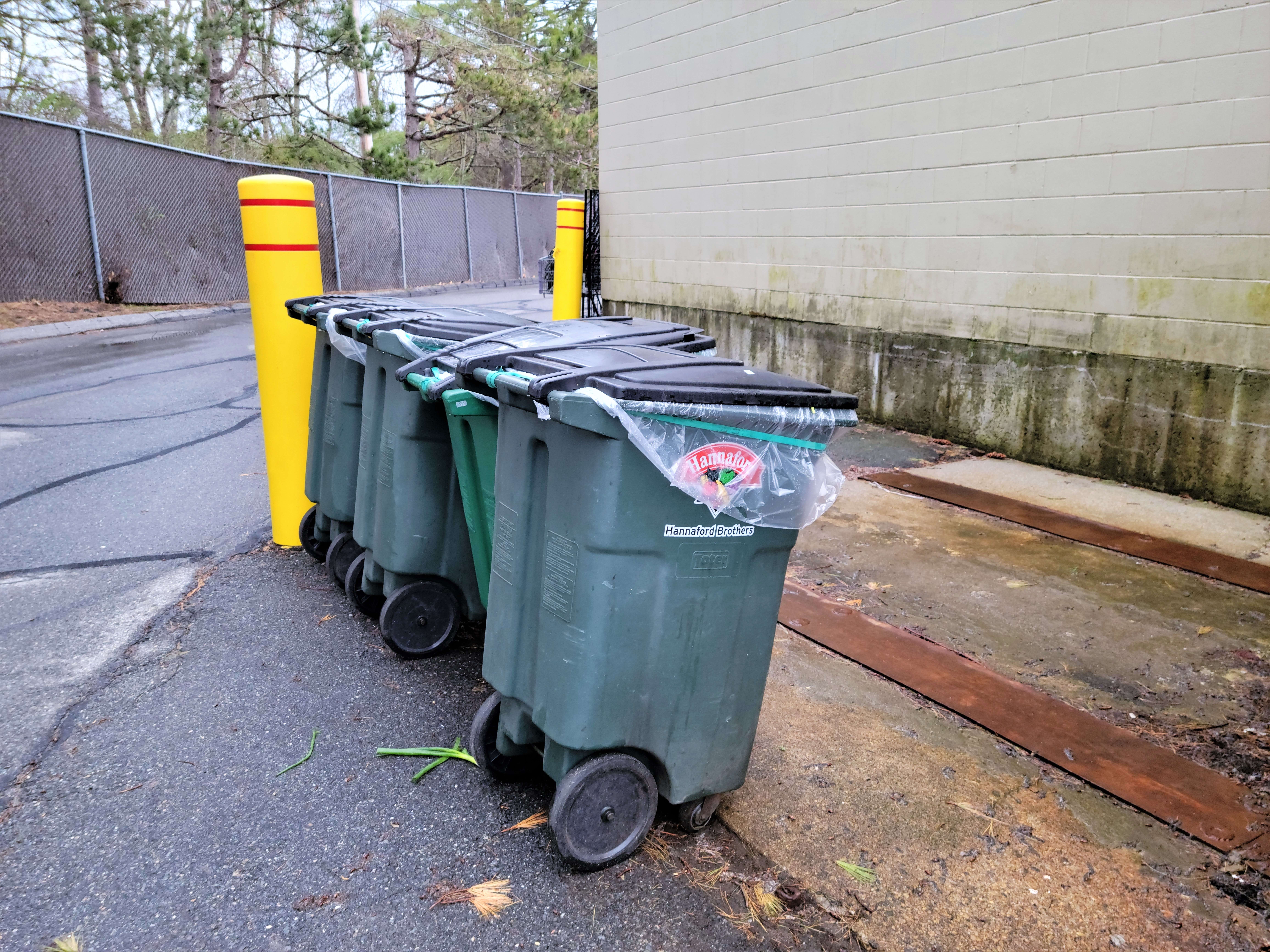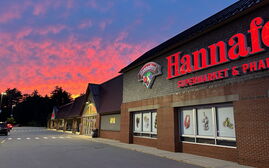
Processing Your Payment
Please do not leave this page until complete. This can take a few moments.
Maine grocers look to cut food waste, but so far progress is a mixed bag
 Courtesy / Agri-Cycle
Food waste generated in grocery stores and supermarkets totals millions of tons each year.
Courtesy / Agri-Cycle
Food waste generated in grocery stores and supermarkets totals millions of tons each year.
It was no surprise that Hannaford Supermarkets chose April 20 — two days before Earth Day, and eight days in advance of the international Stop Food Waste Day this Wednesday — to announce a milestone in reducing food waste. The Scarborough-based company began working early, a decade ago, to shrink the stream of food discarded in garbage landfills.
But while Hannaford may have been early, it’s not alone. Other Maine supermarkets and grocers are working to slim their waste lines, with mixed success.
Hannaford said last week that each of its 183 stores across the Northeast now prevents all unsold food from going to waste, sending none of it to landfills. Hannaford kept 65 million tons of food out of landfills last year, according to a news release from the company, and in the process donated more than 25 million pounds of meat, produce, pasta, eggs and other food to local hunger relief organizations.
“When we first established this goal, it was with the greater purpose of making a real and positive impact on our communities,” President Mike Vail said. “Eliminating hunger and food waste are essential to improving the world we live in.”
Hannaford’s announcement prompted praise from Gov. Janet Mills, Maine’s congressional delegation, environmental officials and others. The company’s work has also gotten high marks in an industry report card.
Ahold Delhaize USA, Hannaford’s parent company, received an “A” grade in a recent evaluation of supermarkets’ food waste reduction efforts. The company tied with Kroger Co. and Walmart Inc. in receiving the highest possible score in the analysis by the Center for Biological Diversity, a national advocacy group headquartered in Arizona.
The analysis, “Slow Road to Zero: A Report Card on U.S. Supermarkets’ Path to Zero Food Waste,” graded 10 major grocery chains on their commitment to zeroing food waste as well as transparency about their progress. The report was released in September 2019 and updated one in 2018 by the center. It didn’t publish a report last year, nor does it appear that any other credible third party has issued similar grocery garbage grades.
Ahold Delhaize received a grade of C in the 2018 report, so the more recent evaluation represents improvement. The grades for other companies with Maine stores have been mediocre.
Albertsons Cos. Inc., the owner of Shaw’s supermarkets in Maine, received a C in both report cards. Whole Foods Market and Target Corp. each received a B in 2019, after each got a D the previous year. In both 2019 and 2018, Trader Joe’s received a D.

Susanne Lee, a faculty fellow at the University of Maine’s Sen. George J. Mitchell Center for Sustainability Solutions, is familiar with the efforts of the state’s grocers. She leads an industry-university collaboration to slash food waste in Maine, and the group held its first public summit on the problem earlier this month.
“Hannaford has really been a leader, but some other companies haven’t been as eager to talk about food waste,” she said in an interview last week. “They do what they do, but it’s not really so much about Maine.”
A multi-faceted problem
Food waste has created growing concerns in recent years. The U.S. discards more food than any other country in the world, including 63 million tons in 2018, according to the Environmental Protection Agency. It’s estimated that between 30% and 40% of all food ends up in the waste stream, and makes up 22% of all municipal solid waste.
Besides costing Americans $218 billion annually, wasted food fills up landfills, creates methane and other greenhouse gases, and contributes to a hunger crisis in which an estimated 215,000 Mainers experience food insecurity — at last count, the 12th-highest rate in the country, according to the Auburn-based Good Shepherd Food Bank.
ReFED, a national nonprofit, estimates that food retailers generate 10.5 million tons of food waste annually, dumping almost one-third of it into landfills.
But the industry is trying to change that, says Christine Cummings, executive director of the Maine Grocers & Food Producers Association.
“In general, grocers as the retail, consumer-facing entity of the food supply chain are very much aware of the issue of food waste,” she told Mainebiz in an interview last week.
“They are seeking out more information and ways to proactively reduce food waste and to ensure they continue to serve as good stewards of their communities and environment. They actively engage in donation and recycling programs and are learning and implementing new strategies to reduce food waste that in turn also help with their efficiencies and cost savings.”
The U.S. has set a goal of reducing food waste 50% by 2030, and most major grocery businesses have signed on to meet that goal. One of the keys is a process the EPA calls the Food Recovery Hierarchy. Most major supermarkets say they follow the process, which basically means upstream reductions in the amount of food that can be wasted, and then triaging unsold food to where it can do the most good.
Surplus inventory is donated to food banks and other organizations that feed hungry people; food that can’t feed people goes to farmers to feed animals; and food that can’t feed anyone is converted into energy or composted. Landfilling is the last resort.

In Maine, Hannaford has been working since 2013 with another Scarborough company, Agri-Cycle Energy, and its sister company Exeter Agri-Energy, to biologically convert food waste into electricity that is sold back onto the grid.
Agri-Cycle’s operation includes a state-of-the-art de-packaging machine that separates expired or damaged packaged food from its container — allowing for easy recycling of food waste that would otherwise end up in a landfill due to its packaging. Besides Hannaford, the company has also worked with Trader Joe’s, Walmart and Whole Foods.
In addition, Whole Foods operates “anaerobic digesters” of its own to convert food waste, according to a spokesman for that chain.
“Many of our stores participate in food waste diversion and recycling programs, such as composting, anaerobic digestion to create renewable energy, and animal feed programs,” Spencer Taylor told Mainebiz.
Like Hannaford, Whole Foods also donates its products, including 200,000 meals in Maine last year. The company has pledged to reduce food waste in its stores by 50% over the next decade, Taylor said.
Shaw’s and its affiliated Massachusetts chain, Star Market, donated 2 million pounds of food last year, Albertsons spokesman Andrew Whelan told Mainebiz. Roughly 95% of the 150-plus stores in Maine and Massachusetts participated in the effort.
“While food waste happens throughout the supply chain — from farms, to transportation, to stores, and homes — we believe that as a grocery retailer and manufacturer that it’s our job to get food from our stores to our customers with minimal food waste,” Whelan said.
Challenges, but also opportunity
While food-waste initiatives by Hannaford and others represent progress, Maine grocers have their work cut out for them.
Geography is one potential obstacle, according to Cummings.
“Maine’s wide geographic presence is a challenge, especially when it comes to recycling or sustainability efforts in our backyards,” she said. “Access and the ability to fully engage in every and all food waste efforts are certainly relevant to the scale of the operation and dependent on the available network of resources within certain geographic areas of the state.”
While small stores such as Bow Street Market in Freeport have had some success in food waste reduction, Cummings added, many of the state’s grocers simply don’t have the resources and scale of a company like Hannaford.
“Larger storefronts have capabilities and full sustainability programs whereas smaller storefront owners would love to be able to do that, but are wearing multiple hats.”
Lee, however, believes there’s a big opportunity for small grocers to reduce food waste, if they only know how. To that end, she and a team of college students are working with MGFPA and others to produce a toolkit showing food retailers in Maine where to begin.
The toolkit includes basic information about the process and why reducing food waste makes sense in an industry with tight profit margins. There's even an analysis that will forecast a business' potential savings.
“When you’re in a business with like a 2% margin, you need to look at every chance to manage costs. Reducing waste is just good business sense,” Lee said.
“Our Mitchell Center faculty-student team really believes this is Maine's best opportunity to generate economic benefits, societal benefits and environmental benefits by seeing food not as ‘waste’ but as a solution.”














0 Comments